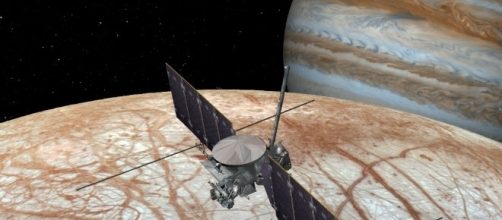NASA Hubble scientists announced what looks like a recurring plume of water jetting from the frozen surface of Europa, providing another tantalizing hint of the possibility of Alien Life on Jupiter's fourth largest moon. The geyser of water ejected 62 miles or about 100 kilometers from the surface of the ice near the moon's equator.
Icy plumes on Jupiter's moon
The announcement about Europa was published as a paper in "The Astrophysical Journal Letters" on Thursday, April 13, 2017. It comes as just another of the clues that have consistently pointed towards the possibility of oceans under the ice shell of the frozen moon, with a complicated geology that may even support the conditions necessary for alien life.
Observations from missions going back to Voyager 1 and 2, and Galileo, discovered evidence of tidal forces that kept the oceans of Europa unfrozen underneath the ice crust. Galileo found a spot that seemed particularly warm, where the ice was thinner. That's the very location where Hubble has observed plumes of water vapor spewing from the ice, first in 2014 and then again in 2016.
.@NASAHubble has captured even more evidence of water vapor plumes on Jupiter's icy moon Europa. More: https://t.co/EXf2dtbbwE #OceanWorlds pic.twitter.com/mAv1dqGqj0
— NASA (@NASA) April 13, 2017
The recurring plume surprised and excited researchers. On the same day, NASA's Cassini Mission team announced the discovery of hydrogen in a similar plume erupting from the surface of Saturn's moon, Enceladus.
Enceladus is also a frozen world on the outside, but a churning tidal ocean twice the size of earth on the inside. The detection of hydrogen suggests that the layer of ice interacts chemically with the moon's rocky core, which can be a source of energy fueling alien life in the ocean.
Alien life in ocean worlds
Even though the Cassini Mission's findings are more specific, many scientists believe Europa is actually the better candidate when it comes to the search for alien life.
Jupiter and its moons are older than Saturn and Enceladus, meaning Europa has simply had more time to develop the basics of life as we know it.
While Europa is roughly the same size as our own Moon, it actually contains more water than here on Earth. Hubble will continue to survey Europa's surface for further evidence of plumes, particularly at the known warm spots.
Europa Clipper
Interestingly, neither the Cassini nor Hubble missions are designed specifically to look for signs of life. But, our evolving understanding of these curious, frozen ocean worlds continues to point to the tantalizing possibility of alien life.
The next step comes in the form of the Europa Clipper mission, set to begin sometime in the 2020s. The mission will take images and gather data in a rapid series of multiple flybys. What NASA has learned during both the Hubble and Cassini missions so far will go towards developing next generation instrumentation for the Europa Clipper mission in its search for the conditions suitable for alien life on Jupiter's moon.

